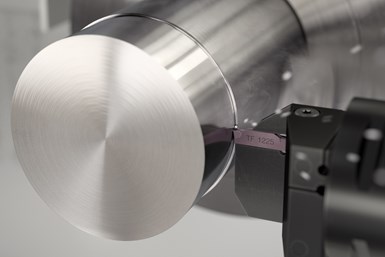Sandvik Coromant Grooving Tool Provides Stable Performance
The CoroCut 2 system features an improved clamping finger design, which offers a higher clamping force and better side stability.
Sandvik Coromant is upgrading its CoroCut 1-2 parting and grooving concept to provide improved stability, greater flexibility and significant productivity gains with the new CoroCut 2 system.
Stability is key when working with all parting and grooving operations. The main challenge is keeping the insert in place to minimize all forms of insert movement. The rail interface, previously available on medium and large inserts, offers more precise insert positioning and makes the insert resilient to any lateral forces exerted on it. This rail interface will now also be available on smaller insert sizes, providing stability in all operations.
CoroCut 2 parting blades are upgraded with internal coolant and an improved clamping finger design, which offers a higher clamping force and better side stability. Toolholders with precision coolant are updated with a screw clamp solution, which — combined with the rigid rail insert seat design — keeps insert movement to a minimum without any loss of clamping force.
Other important features included in the upgrade are new and updated grades and geometries, including the new first choice grade GC1225, a wiper design for all parting geometries and greatly enhanced edge line quality on all inserts.
CoroCut 2 can be used in all types of parting and grooving applications with cutting depths suitable for double-edged inserts. The related CoroCut QD and CoroCut QF concepts are recommended for larger depths of cut, while CoroCut QI is the specialized for internal grooving and face grooving on small diameters.
Related Content
-
Broaching Tool Technology For Lathes Used to Slot Inconel Parts
This shop finds value in using an indexable-insert-style broaching tool to create blind-hole slots in heat-treated Inconel aerospace parts on a CNC lathe.
-
Replaceable-Insert Spade Drill Basics, Advantages
Although solid carbide and indexable-insert drills have their place in a machine shop, replaceable-insert spade drills offer specific advantages for various holemaking operations on machining centers and lathes.
-
Shop Sets its Sights on Precise Tool Alignment
A Wisconsin shop has found that visual tool alignment technology has improved tool life and surface finishes for its Swiss-type lathes while increasing throughput as well.














.png;maxWidth=300;quality=90)


